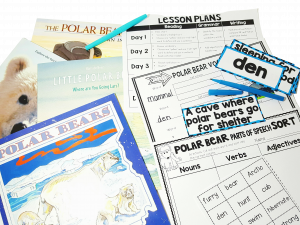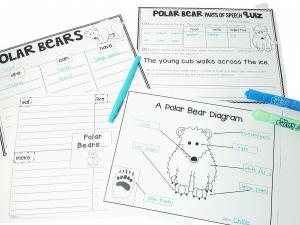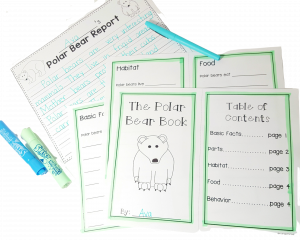Informational writing can be fun and exciting for young learners! With these simple strategies, your students will become experts at informational writing!
How to teach informational writing
My first suggestion is to walk through the informational writing process together as a class first. Research the same topic, guide students in gathering important information, and take it step-by-step. We all write about the same topic but don’t write the exact same thing. We work on putting information into our own words through a lot of modeling and sharing.

My favorite whole-class informational writing project is all about polar bears!
Once we have completed a project together, students enjoy choosing a topic of interest and reading about their subject. While I typically choose an umbrella topic like Arctic animals or biographies, I allow students to choose their own specific topic.
Informational Writing Anchor Charts
Anchor charts are effective tools for teaching informational writing to young writers. By visually displaying information in the form of pictures and keywords, writers can more easily refer back to what they have learned. Anchor charts provide structure and support that helps young writers organize their thoughts into a cohesive structure. It’s important that anchor charts are kept visible in the classroom, such as on bulletin boards or where students can view them while they write, as an effective reference tool. Anchor charts can help build student confidence in story organization and gain skills in effective writing.
Graphic Organizers
Graphic organizers can be really helpful when it comes to organizing information in a writing piece. This tool allows students to organize their thoughts and data into visual structures and get an overview of what their final work will look like. With graphic organizers, students can organize their thoughts, decide on the topics for each paragraph, plan the transitions and flow throughout their writing, add details surrounding the main ideas, and organize their evidence.

Graphic organizers are also great because they make complicated topics easier to understand by clearly outlining relationships between facts or statements without having to write out sentences or paragraphs. With this helpful tool, completing an informational assignment becomes manageable!
Mentor Texts
Teaching young writers can be a lot of fun, especially when you use mentor texts! Mentor texts are published books that teachers can use to model writing for their students. By using mentor texts, students get to explore the different kinds of writing out there and emulate authors – all while learning the elements of good writing in a fun way. Plus, it’s a great way to bring subjects like science, history, and math through story form.
Nonfiction Text Features
Informational writing requires teaching about nonfiction text features. To be completely honest, when I first started teaching I went about this ALL wrong. I tried to teach too many text features at once. I learned that simple and slow is always better. And, I also learned to prioritize which text features to teach. Instead of trying to cram 12 text features into one writing project, I might focus on 4-5 and then scaffold the next time and add some more. During mini-lessons, I focus on just one text feature per day.

Informational Writing Rubric
Using a rubric allows students to set goals for their writing. I find it helpful to provide examples of writing that fits the criteria so they can see exactly what they are aiming for. I typically copy a few former students’ writing to keep on hand. Or, I write them myself. You can Google Search for some printable examples as well.
I hope these simple strategies for teaching informational writing are helpful for you and your students! It’s crucial to remember that the process is just as important as the product. Don’t let perfect get in the way of “good”. Your students’ writing doesn’t need to be beautifully polished in order to be a success!
Looking for more ways to engage your writers? Check out this post!


